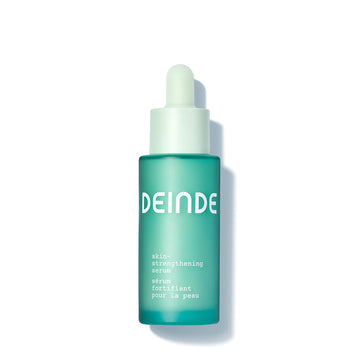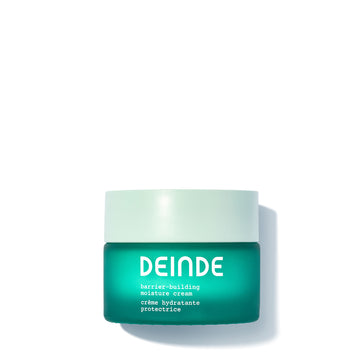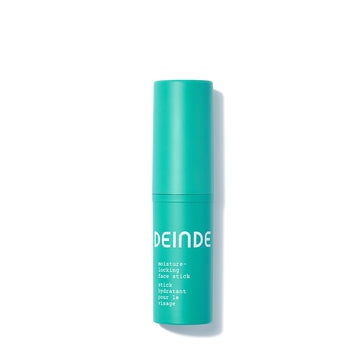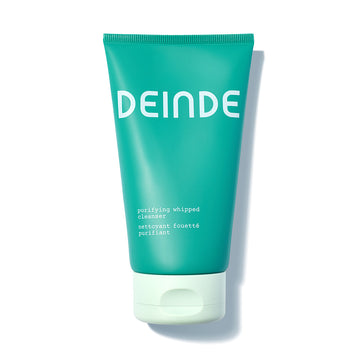
Signs Your Skin Barrier Is Damaged and How To Repair It
Even those of us deep in the skincare industry need to be reminded that the skin is one of the most complex organs in the body. Eternally in a cycle of renewal and adaptation, skin is resilient and dynamic. And at the helm of this intricate system that serves as the body’s frontline of defense against external threats? That would be the skin barrier.
You’ll often hear the adage that when the skin is suffering, it will visually tell you. Irritation, relentless itching, cracks reminiscent of the Sahara — these are signs that your skin barrier needs some attention. Skin barrier damage is relatively common, a compounding result of using harsh cleansers, extreme weather, excessive UV radiation, chronic inflammation, or poor nutrition.
What is the role of the skin barrier?
Think of the skin barrier (used interchangeably with the moisture barrier or acid mantle) as your skin’s outermost layer and your body’s first line of defense against external stressors — a healthy skin barrier protects you from harmful inputs like microorganisms, pollutants, etc., regulates temperature, and prevents transepidermal water loss. The barrier is slightly acidic, which allows for an ecosystem that’s unfavorable for pathogenic microorganism growth.
The skin barrier, also known as stratum corneum, is what we see on the surface. It’s composed of up to 20 compressed layers of corneocytes (dead skin cells) bonded by a lipid matrix of ceramides, cholesterol, fatty acids, etc. These layers contain abundant levels of keratin, a protein that provides structural integrity to the skin barrier. The lipid matrix acts as a glue of sorts, playing a critical role in preventing water loss and pathogenic microorganisms from entering the barrier. These layers create a complex, flexible structure, key to the body’s defense mechanisms.
Researchers often use the metaphor of a brick wall to describe an intact skin barrier, where the cells are the bricks and lipid layers are the mortar. If this wall is weak, has holes, or is generally poorly built, it can collapse. The same goes for the skin barrier. Among other impacts, a vulnerable skin barrier allows pathogenic bacteria to sneak in and moisture to escape.
What are the signs of a damaged skin barrier?
If you’re dealing with a damaged skin barrier, you may be able to recognize a few key signs:
- Dry, dehydrated, and dull skin → Maybe your skin feels like it simply can’t maintain hydration — or maybe it’s physically flaky and exceptionally dull. These are indicators that, at some level, your skin barrier needs transepidermal water loss addressed, asap
- Overly sensitive skin → When the skin is facing heightened environmental stressors, inflammation, and a lack of hydration, it steps into a panic mode, heightening skin sensitivity as a response
- Breakouts and redness → A damaged skin barrier disrupts the skin’s microbiome and permeability, inviting irritants and skin stressors
What is the relationship between Inflammaging and a damaged skin barrier?
Inflammaging and the skin barrier share an intimate relationship. As a reminder, inflammaging refers to a chronic, low-grade inflammatory state that contributes to age-related diseases as well as weakened immune and tissue function.
In a somewhat cyclical process, a damaged skin barrier is less effective at keeping out irritants, pollutants, and UV damage, allowing them to enter the skin and triggering inflammaging. At the same time, low-grade chronic inflammation weakens the skin barrier through a range of processes, including the reduced capacity to repair after trauma. By activating an inflammatory response, the body is constantly releasing inflammatory mediators like cytokines and chemokines, which heighten skin sensitivity and encourage redness, itching, and general discomfort.
This ongoing release interrupts the skin’s barrier function and integrity via:
-
Elastin and collagen breakdown → Inflammaging degrades both collagen and elastin through the production of matrix metalloproteinases (MMPs). The more the body is fighting inflammaging, the more enzymes are released, leading to a reduction in skin barrier resilience. Visually, this manifests through the loss of skin fitness and elasticity
- Weakened corneocyte structure → Chronic low-grade inflammation alters the structure of corneocytes (layered skin cells) leading to abnormalities. This makes for a compromised skin barrier that is unable to effectively lock in moisture and protect against environmental stressors
-
Altered lipid composition → When the body is in a state of sustained inflammation, the production and distribution of lipids (ceramides, cholesterol, fatty acids) can be disrupted, thus impacting the protective nature of the skin barrier
- Increased sensitivity → Inflammaging puts the body in a fight or flight mode, always activated and combating inflammation. Due to this, skin can become reactive and sensitive, compounding and compromising the basic functions of the skin barrier. A dysregulated skin barrier may aggravate pre-existing conditions like eczema, rosacea, or psoriasis — furthering skin barrier damage along the way
How does the skin barrier change as we age?
Skin, ever dynamic, becomes thinner the longer we move through the world. This is due to the reduction of collagen and elastin production. At the same time, the lipid matrix becomes less efficient, requiring external hydration to account for increased dryness. Inflammaging further weakens the barrier’s function and contributes to age-related issues like fine lines.
Cause and effect: How to protect the skin barrier
The skin barrier is a complex system composed of multiple layers that shield from the entry of pathogenic microorganisms and pollutants, all while retaining essential moisture, playing a role in temperature regulation, and injury. Skin is truly dynamic, and understanding the inputs — and the necessary steps to take to reduce impact — can go a long way when executing the best methods for skin barrier repair and protection.
→ Ultraviolet radiation
UV radiation — via sun exposure — damages the skin barrier through the generation of free radicals, highly reactive molecules that cause oxidative stress. When the skin faces oxidative stress, it triggers inflammation and directly impacts the structural integrity of the skin barrier. Collagen and elastin fiber breakdown follows, leaving the skin vulnerable to environmental threats and susceptible to accelerated aging.
Protect with → SPF and physical sun protection — think large hats, long sleeves, etc. Broad-spectrum sunscreen shields against UVA and UVB rays, mitigating oxidative stress and free radical formation to support your skin health.
→ Pollution
Our environment — particularly the air we exist in — can play a significant role in skin barrier health. Excess exposure to environmental pollutants and aggressors, like fine particulate matter or volatile organic compounds, can penetrate the skin and trigger oxidative stress. The accumulated impact of pollution exposure weakens skin barrier integrity, making it significantly less impactful when protecting from environmental threats.
Protect with → A skincare routine and diet that’s rich with antioxidants. Antioxidants are known to help soothe skin and support your skin health during exposure to oxidative stress. Diligently cleansing skin to remove any remnants of pollutants can help minimize their interaction with the skin barrier.
→ Unhealthy diets
Sometimes, we have to look at what we’re putting in our body, not just on our skin. An unhealthy diet — high in processed foods, sugars, unhealthy fats, etc. — promotes inflammation in the body and tends to be lacking critical nutrients. The result is skin that is unable to efficiently repair and protect itself.
Protect with → A balanced and produce-rich diet full of antioxidants, vitamins, and essential fatty acids.
→ Chronic Stress
Chronic stress, defined as the ongoing and persistent state of tension and strain, triggers the release of stress hormones (hello cortisol). These stress hormones weaken skin barrier integrity through increased inflammation, impairing the ability to retain moisture and protect. Chronic stress may also exacerbate skin conditions like acne and psoriasis.
Protect with → Stress reduction techniques (yoga, meditation, etc.), sleep, therapy, regular exercise, and a healthy diet — finding balance and managing stress levels will reduce release of harmful stress hormones.
→ Harsh skincare habits
If you’re leaning too heavily into harsh, cosmetic active ingredients and skincare products, your skin barrier is likely suffering. Harsh skincare habits — like over-exfoliation — physically disrupt the balance of the stratum corneum. Natural oils are stripped, the lipid matrix becomes impaired, and the skin barrier becomes vulnerable.
Protect with → A gentle, loving approach to your skincare. Look for nourishing sensitive skin-safe or MyMicrobiome-certified products — the idea is to use formulations that do not strip or disrupt the skin barrier. Reach for gentle cleansers over harsh chemical exfoliants, and seal in your skin’s moisture with humectants to prevent dry skin.
How long does it take a damaged skin barrier to heal?
There isn’t a strict timeline. Depending on if the damage is minor (think temporary dryness) or severe (extensive sun damage) you may be looking at several months for the skin to fully heal.
Time is always a friend for resolving complex skincare issues — especially when you support the process with gentle skincare practices, lifestyle choices that encourage reduced stress, and extensive hydration.
Studies cited:
- Skin barrier function | PMC
- Understanding the Epidermal Barrier in Healthy and Compromised Skin: Clinically Relevant Information for the Dermatology Practitioner | PMC
- Diet and Skin Barrier: The Role of Dietary Interventions on Skin Barrier Function | PMC
- Solar UV radiation reduces the barrier function of human skin | PMC











